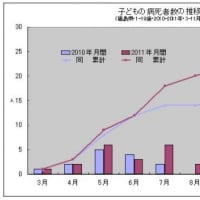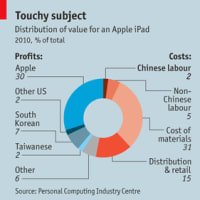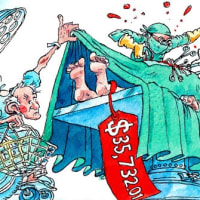たとえグリーンスパンがちょっと良い感じ、とおっしゃったとしても、株価が今後もずっと上がり続けるとか考えるのはどうですかね。本格回復が見えるまでは、またいずれ強烈に下げる局面も出てくる、と考えておくのが直感的には正しいようなきがしますがね。そんな簡単に経済の調整が終わるとは考えにくいですよね。
An astonishing rebound
とか言っておきながら、また回復バナシで恐縮ですが、アジアの驚異的な回復、というわけで、ロンドンエコノミスト誌がアジア新興国の状況を簡単にまとめてくれてますな。
Earlier this year it was argued that such export-dependent economies could not revive until customers in the rich world did. The West still looks weak, with many economies contracting in the second quarter, and even if America begins to grow in the second half of this year, consumer spending looks sickly.
もともとアジアは輸出依存の経済で、西側のリッチ諸国の回復がないと、アジアも回復しないという人もいたわけですが、まだ、西側は下げがソフトになっただけで
回復には遠いわけですが・・・、
The four emerging Asian economies which have reported GDP figures for the second quarter (China, Indonesia, South Korea and Singapore) grew by an average annualised rate of more than 10% (see article). Even richer and more sluggish Japan, which cannot match that figure, seems to be recovering faster than its Western peers.
中国、インドネシア、韓国、シンガポールの年率換算の第二QのGDPは10%を超える成長。金持ちの日本も及ばない。
何でここで日本を出すかね。日本と新興国の成長率を比べる? ほんま、おっこるで(横山やすし風に)。
South Korea’s GDP grew by an annualised 10% in the second quarter. Taiwan’s probably increased by even more: its industrial output jumped by an astonishing annualised rate of 89%. India was hit less hard by the global recession than many of its neighbours because it exports less, but its industrial production has also perked up, rising by a seasonally adjusted rate of 14% in the second quarter.
韓国10%、台湾89%、インド14%。台湾89%。まあ、台湾は落ち方も激しかったですからなあ。
台湾も大変
Asia’s rebound has several causes.
この回復にはいくつか要因があって、
First, manufacturing accounts for a big part of several local economies, and industries such as cars and electronics are highly cyclical: output drops sharply in a downturn and then spurts in the upturn.
おおきな比率を占める自動車や電機は、循環性が高い。落ちるときには激しくおちて、回復するときはバシッと回復する。
Second, the region’s decline in exports in late 2008 was exacerbated by the freezing up of global trade finance, which is now flowing again.
2つ目の要因としては、08年後半の輸出の悪化は、世界的な貿易金融の機能停止によっても悪化させられていたという事情があって、今は金融も機能回復している。
こんなニュースもありましたなあ。中国はどうよ
Third, and most important, domestic spending has bounced back because the fiscal stimulus in the region was bigger and worked faster than in the West.
3つ目。一番大事な点は、政府の財政刺激策が、西側のリッチ諸国より規模が大きく、効きも良いってこと。
India aside, the Asians entered this downturn with far healthier government finances than rich countries, allowing them to spend more money.
インドは別として、政府財政がずっと健全で、支出がしやすい。
Low private-sector debt made households and firms more likely to spend government handouts;
私的部門の家計部門も企業部門も、債務が小さく、政府から移転された所得をそのまま支出に回しやすい(貯蓄に回らず支出されて経済が刺激される)。日本じゃ公共事業は効かないんだ、みたいなハナシの裏返しですな。
Asian banks were also in better shape than their Western counterparts and able to lend more.
銀行の状態も良いので、貸し出しも実行しやすい。
Asia’s prudence during the past decade did not allow it to escape the global recession, but it made the region’s fiscal and monetary weapons more effective.
アジアのこの10年間の分別ある態度をもってしても、世界不況を逃れることはできなかったが、それは、金融、財政手段をずっと効果的なものにしている。
今こそケインズ政策だ、みたいなクルーグマンの主張が、アジアで有効だというのがちょっと皮肉なんですな。どこもかしこもメタメタで、政府しかないんだ、というのではなく、結構健全なアジアで効いたって・・・。
An astonishing rebound
とか言っておきながら、また回復バナシで恐縮ですが、アジアの驚異的な回復、というわけで、ロンドンエコノミスト誌がアジア新興国の状況を簡単にまとめてくれてますな。
Earlier this year it was argued that such export-dependent economies could not revive until customers in the rich world did. The West still looks weak, with many economies contracting in the second quarter, and even if America begins to grow in the second half of this year, consumer spending looks sickly.
もともとアジアは輸出依存の経済で、西側のリッチ諸国の回復がないと、アジアも回復しないという人もいたわけですが、まだ、西側は下げがソフトになっただけで
回復には遠いわけですが・・・、
The four emerging Asian economies which have reported GDP figures for the second quarter (China, Indonesia, South Korea and Singapore) grew by an average annualised rate of more than 10% (see article). Even richer and more sluggish Japan, which cannot match that figure, seems to be recovering faster than its Western peers.
中国、インドネシア、韓国、シンガポールの年率換算の第二QのGDPは10%を超える成長。金持ちの日本も及ばない。
何でここで日本を出すかね。日本と新興国の成長率を比べる? ほんま、おっこるで(横山やすし風に)。
South Korea’s GDP grew by an annualised 10% in the second quarter. Taiwan’s probably increased by even more: its industrial output jumped by an astonishing annualised rate of 89%. India was hit less hard by the global recession than many of its neighbours because it exports less, but its industrial production has also perked up, rising by a seasonally adjusted rate of 14% in the second quarter.
韓国10%、台湾89%、インド14%。台湾89%。まあ、台湾は落ち方も激しかったですからなあ。
台湾も大変
Asia’s rebound has several causes.
この回復にはいくつか要因があって、
First, manufacturing accounts for a big part of several local economies, and industries such as cars and electronics are highly cyclical: output drops sharply in a downturn and then spurts in the upturn.
おおきな比率を占める自動車や電機は、循環性が高い。落ちるときには激しくおちて、回復するときはバシッと回復する。
Second, the region’s decline in exports in late 2008 was exacerbated by the freezing up of global trade finance, which is now flowing again.
2つ目の要因としては、08年後半の輸出の悪化は、世界的な貿易金融の機能停止によっても悪化させられていたという事情があって、今は金融も機能回復している。
こんなニュースもありましたなあ。中国はどうよ
Third, and most important, domestic spending has bounced back because the fiscal stimulus in the region was bigger and worked faster than in the West.
3つ目。一番大事な点は、政府の財政刺激策が、西側のリッチ諸国より規模が大きく、効きも良いってこと。
India aside, the Asians entered this downturn with far healthier government finances than rich countries, allowing them to spend more money.
インドは別として、政府財政がずっと健全で、支出がしやすい。
Low private-sector debt made households and firms more likely to spend government handouts;
私的部門の家計部門も企業部門も、債務が小さく、政府から移転された所得をそのまま支出に回しやすい(貯蓄に回らず支出されて経済が刺激される)。日本じゃ公共事業は効かないんだ、みたいなハナシの裏返しですな。
Asian banks were also in better shape than their Western counterparts and able to lend more.
銀行の状態も良いので、貸し出しも実行しやすい。
Asia’s prudence during the past decade did not allow it to escape the global recession, but it made the region’s fiscal and monetary weapons more effective.
アジアのこの10年間の分別ある態度をもってしても、世界不況を逃れることはできなかったが、それは、金融、財政手段をずっと効果的なものにしている。
今こそケインズ政策だ、みたいなクルーグマンの主張が、アジアで有効だというのがちょっと皮肉なんですな。どこもかしこもメタメタで、政府しかないんだ、というのではなく、結構健全なアジアで効いたって・・・。




















※コメント投稿者のブログIDはブログ作成者のみに通知されます